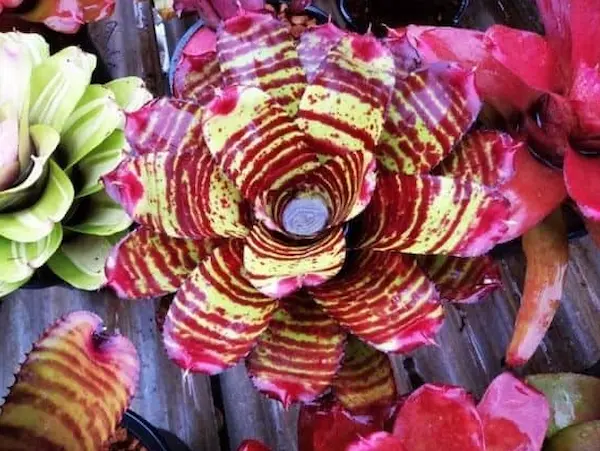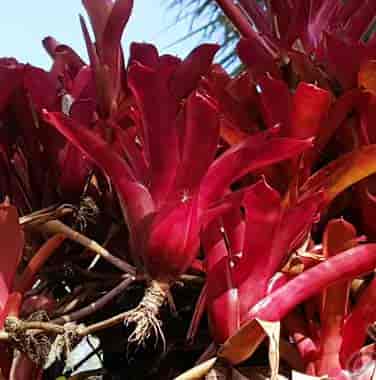Neoregelia Bromeliad Care Tips
Bromeliads are popular for adding colour both indoors and out. We frequently encounter the “Silver Vase” Aechmea Fasciata inside. Another popular bromeliad is Neoregelia. The thick, robust leaves and centres colour everything and provide a wide range of appealing tints and strong colours.
Neoregelias look fantastic as solitary plants or in groupings. Ideal for a patio with some mild shade or a balcony in need of long-lasting colour. Neoregelia is a bromeliad that may complement your cactus and/or succulent collection. This intriguing plant may add diversity and colour to your collection, but the amount of care required is comparable to that of cacti and succulents.
Here’s our full article on bromeliads.
- Introductory Video
- What Are Bromeliad Plants?
- When Do Neoregelias Bloom?
- What Are The Most Popular Varieties of Neoregelia?
- How Large Can Neoregelia Grow?
- What Kind Of Lighting And Temperature Does Neoregelia Plants Need?
- How Much Water Does Neoregelia Need?
- What Is The Purpose Of The Bromeliad Funnel?
- What Is The Best Neoregelia Bromeliad Soil To Use?
- How Often Should You Repot Neoregelias?
- What Kind Of Plant Fertilizer Should You Use On Bromeliads?
- Can You Put Fertilizer The Bromeliad Funnel?
- How Do You Propagate Bromeliads?
- How Long Does It Take For A Neoregelia To Bloom?
- What Are The Most Common Problems For Neoregelia?
- What Pests Attack Neoregelias?
- Tips For Buying A Neoregelia Bromeliad
Introductory Video
What Are Bromeliad Plants?
Neoregelia leaves in the center of the plant form a funnel and take on a lovely purple or red hue prior to blooming. Flowers appear randomly at the base of the funnel.
When Do Neoregelias Bloom?
The small blooms often develop in the summer, but they can appear at any time as long as the plant is kept in ideal circumstances. Neoregelia blooms are short-lived and scentless, yet they are quite attractive. They grow among vibrant centre leaves that hold their purple or scarlet hue for months.

What Are The Most Popular Varieties of Neoregelia?

This species features a large rosette of brilliant green leaves with a crimson or purple funnel. When the blooms appear, they are a lovely shade of violet. This plant has a “Tricolor” variant. The leaves of this plant have creamy yellow/white streaks running through them. The bands turn a beautiful crimson when the plant is preparing to blossom. The small Neoregelia “Fireball,” with its blazing red foliage, is another popular variety.
When bloom time approaches, the center of the plant turns pink. When blossoms appear, they are a lovely shade of lilac. Meyendorfii is another popular variety which features very wide leaves in an interesting shade of olive green. The center of the plant turns brown at bloom time.
How Large Can Neoregelia Grow?
These plants are fairly compact and usually grow to be about sixteen inches high and one or two feet wide. The leaves grow in an attractive rosette pattern which forms a central funnel.
What Kind Of Lighting And Temperature Does Neoregelia Plants Need?
Just like cactus and succulents, Neoregelia loves the sun. Bright, ample sunlight produces deep, attractive leaf colors. Of course, you should not expose this or any plant to very bright, hot, direct midday sun because direct sunlight (especially through glass) can actually scorch the leaves.
How Much Water Does Neoregelia Need?
Even though they are good companions for cacti and succulents, bromeliads do need a bit more water. In the summertime, keep the soil moist. In the wintertime, allow it to dry completely before watering lightly. The central funnel should be kept filled with pure filtered, distilled or rainwater year-round. More in our article – Bromeliad Watering – HOW TO
Be mindful of the weather. If it is hot and dry, your plant will need more water. Your plants might enjoy occasional misting in very hot, dry weather. If it is muggy, your plant will need less water and may benefit from having a fan set up to provide indirect air movement.
What Is The Purpose Of The Bromeliad Funnel?
All varieties of this plant have narrow, stiff leaves in the center which grow in a funnel shape. In the wild, condensed moisture collects in the funnel to keep the plant watered. Sometimes little frogs or other amphibians set up housekeeping in the little pool. Keep the funnel filled with water throughout the year to provide the water the plant needs. Flowers will grow in the center of the funnel when the plant is happy and well-cared-for.
What Is The Best Neoregelia Bromeliad Soil To Use?
Actually, Bromeliads need no soil!
The Neoregelia is an epiphytic bromeliad. As such, these plants have compact root systems primarily used to anchor the plant and not for the uptake and retention of moisture and nutrients. Like all epiphytes, Neoregelia need a light, quickly draining mix that does not have a great deal of water holding capacity.
According to the Bromeliad Society of Houston a very light, well-drained no-soil mixture of bark nuggets and peat is a good combination. Alternately, a combination of equal parts coarse perlite, vermiculite and Canadian peat is appropriate.
The main thing to remember is that the “soil” is intended to simply hold the plant in place. It should not be nutrient rich, nor should it retain a great deal of water as these qualities will cause root and plant rot. [source]
How Often Should You Repot Neoregelias?
These bromeliads have very small root systems, so frequent repotting is not necessary. If a plant outgrows its pot or becomes too top-heavy, you can repot it in the springtime before the growing season begins.
What Kind Of Plant Fertilizer Should You Use On Bromeliads?
Provide a very light fertilizing (use slow release fertilizer) to the soil a couple of times during the growing season. If using a water-soluble liquid fertilizer concentrate mix prepare the solution at half the manufacturer’s recommended strength.
Can You Put Fertilizer The Bromeliad Funnel?
Just fertilize the potting medium very lightly a couple of times during the spring and summer months. Only add pure, filtered water, distilled water or rain water to the funnel.
How Do You Propagate Bromeliads?
These plants can be grown from divisions or from seed. Divisions are typically easier to work with and more readily available. Seed can be purchased online or from specialty nurseries or fanciers. Even though it is possible to grow Neoregelia from seed, it is really much easier to simply divide the plants.
Like many plants, the mother plant produces offsets which grow rapidly into independent adult plants. When you see that your plant has produced one or more offsets, continue to care for the plant as usual. Wait until the baby plants are about half the size of the parent plant. More in our article on Removing Flowers and Separating Bromeliad Pups
Prepare the right number of pots for your new plant(s) by filling them with a light, well-draining soil-free mixture as described above.
Tip the adult plant out of its pot and gently cut the offsets loose using a very sharp, clean knife or clippers. Be careful to give the offshoots enough roots to survive. If you cut it separate from all its roots, it will die.
Put the offshoots into their new pots. Cover them with a plastic bag for several days to hold in the moisture and help them get a good start. Be sure to set up a wireframe or a support rod inside the bag to prevent it touching the vegetation of your new plant. Alternately, if you would like to have a cluster of plants, you can simply leave the pups in place. The parent plant will die back after producing offshoots. Remove it to leave more room for the plantlets to grow.
How Long Does It Take For A Neoregelia To Bloom?
Don’t be disappointed if your baby plants don’t bloom right away. They will not bloom until they are fully mature (two or three years old). Satisfy yourself with enjoying their foliage (which is gorgeous) until the first bloom time arrives. You will surely be thrilled after your long and patient vigil!
What Are The Most Common Problems For Neoregelia?
One of the most common problems for these plants is excessive watering. Too much water can cause the plant’s lower leaves to dry and turn brown. This may make you think you need to water more, but this is not the case. To treat this problem, cut off the damaged leaves and reduce watering.
Keeping the soil too soggy can cause the plant’s roots and base to rot. If the flesh of the plant becomes black and soggy at the soil line, you have been watering too much. Withhold all water from the planting medium and hope for the best. Of course, bromeliads can also suffer from too little water. If the tips of the leaves turn brown, it means that the air surrounding the plant is too dry. Regular misting can help.
You may also want to put your plant (pot and all) on a tray of pebbles with water poured over the pebbles (not touching the bottom of the pot). As the water evaporates, the air surrounding the plant will gain a little humidity.
What Pests Attack Neoregelias?
Over watering plants of all sorts can lead to attacks by aphids, insect scale on plants and mealybug pests. More on what mealy bugs look like and their control. You can prevent and treat aphids by simply wiping the plants’ leaves with a damp cloth on a regular basis. If kept outdoors, your plants may be more subject to scale insect or mealybug infestation.
Fact sheet on Neoregelia bromeliads a video explains – care, sun tolerance, growth habit. and here is
Tips For Buying A Neoregelia Bromeliad
- Plants can be purchased at any time of the year
- Look for plants with undamaged leaves
- Remember: Neoregelia die after flowering, start new plants by removing pups.







Leave a Reply
You must be logged in to post a comment.